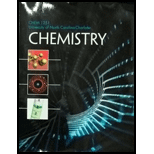
Concept explainers
Calculate the mass of water produced in the example.
(a)
21.02 g
(b)
10.51 g
(c)
11.61 g
(d)
11. 75 g
(e)
5400 g
Use the following information to answer questions 3.2, 3.3, and 3.4.
Calcium phosphide
(Don't forget to balance the equation.)
Interpretation:
The mass of water produced in the given example is to be calculated.
Concept introduction:
Limiting reagent is the reagent that limits the amount of product during the reaction. Actually, it determines the product, as it is present in a lesser amount than required. Other reagents will be present in excess.
Excess reactant is the reactant which is present in larger amount than required.
The required amount of
The required amount of
Answer to Problem 1KSP
Solution: Option (b).
Explanation of Solution
Reason for thecorrect option:
See the balanced chemical equation:
Here,
For
But the available amount of
Since
Hence, option (b) is correct.
Reasons for the incorrect options:
Option (a) is incorrect because according to the above relation, the value
Option (c) is incorrect because according to the above relation, the value
Option (d) is incorrect because according to the above relation, the value
Option (e) is incorrect because according to the above relation, the value
Hence, options (a), (c), (d), and (e) are incorrect.
Want to see more full solutions like this?
Chapter 3 Solutions
CHEMISTRY >CUSTOM<
- The space shuttle environmental control system handles excess CO2 (which the astronauts breathe out; it is 4.0% by mass of exhaled air) by reacting it with lithium hydroxide, LiOH, pellets to form lithium carbonate, Li2CO3, and water. If there are seven astronauts on board the shuttle, and each exhales 20. L of air pee minute, how long could clean air be generated if there were 25,000 g of LiOH pellets available for each shuttle mission? Assume the density of air is 0.0010 g/mL.arrow_forwardFig. 5-5 illustrates a schematic diagram of a combustion device used to analyze organic compounds. Given that a certain amount of a compound containing carbon, hydrogen, and oxygen is combusted in this device, explain how the data relating to the mass of CO2 produced and the mass of H2O produced can be manipulated to determine the empirical formula.arrow_forward3.122 What type of reasoning were we using when we developed the equation for dilution, MiVi=MfVf ?arrow_forward
- A 100.0-g mixture made up of NaCl03, Na2CO3, NaCl, and NaHCO3 is heated, producing 5.95 g of oxygen, 1.67 g of water, and 14.5 g of carbon dioxide. NaCl does not react under the conditions of the experiment. The equations for the reactions that take place are: 2NaClO3(s)2NaCl(s)+3O2(g)Na2CO3(s)2Na2O(s)+CO2(g)2NaHCO3(s)Na2O(s)+2CO2(g)+H2O Assuming 100% decomposition of NaClO3, Na2CO3, and NaHCO3, what is the composition of the mixture in grams?arrow_forward4.44 Industrial production of hydrogen gas uses the reaction shown below. If 1.00 metric ton of propane reacting with excess water yields 270 kg of H2, what is the percentage yield? C3H8(g)+3H2O(l)3CO(g)+7H2(g)arrow_forwardBacterial digestion is an economical method of sewage treatment. The reaction is an intermediate step in the conversion of the nitrogen in organic compounds into nitrate ions. What mass of bacterial tissue is produced in a treatment plant for every 1.0 104 kg of wastewater containing 3.0% NH4+ ions by mass? Assume that 95% of the ammonium ions are consumed by the bacteria.arrow_forward
- 3.105 Nitric acid is often sold and transported as a concentrated 16 M aqueous solution. How many gallons of such a solution would be needed to contain the roughly 2.1109 pounds of HNO3 produced annually in the United States?arrow_forwardWrite an equation from the following description: reactants are gaseous NH3 and O2, products are gaseous NO2 and liquid H2O, and the stoichiometric coefficients are 4, 7, 4, and 6, respectively.arrow_forwardOne method for determining the purity of a sample of titanium(IV) oxide, TiO2, an important industrial chemical, is to react the sample with bromine trifluoride. 3 TiO2(s) + 4 BrF3() 3 TiF4(s) + 2 Br2() + 3 O2 (g) This reaction is known to occur completely and quantitatively. That is. all of the oxygen in TiO2, is evolved as O2 Suppose 2.367 g of a TiO2-containng sample evolves 0.143 g O2. What is the mass percent of TiO2 in the sample?arrow_forward
- Many cereals are made with high moisture content so that the cereal can be formed into various shapes before it is dried. A cereal product containing 58% H2O by mass is produced at the rate of 1000. kg/h. What mass of water must be evaporated per hour if the final product contains only 20.% water?arrow_forward3.115 The average person exhales 1.0 kg of carbon dioxide in a day. Describe how you would estimate the number of CO2 molecules exhaled per breath for this average person.arrow_forward
 Chemistry: An Atoms First ApproachChemistryISBN:9781305079243Author:Steven S. Zumdahl, Susan A. ZumdahlPublisher:Cengage Learning
Chemistry: An Atoms First ApproachChemistryISBN:9781305079243Author:Steven S. Zumdahl, Susan A. ZumdahlPublisher:Cengage Learning World of ChemistryChemistryISBN:9780618562763Author:Steven S. ZumdahlPublisher:Houghton Mifflin College Div
World of ChemistryChemistryISBN:9780618562763Author:Steven S. ZumdahlPublisher:Houghton Mifflin College Div World of Chemistry, 3rd editionChemistryISBN:9781133109655Author:Steven S. Zumdahl, Susan L. Zumdahl, Donald J. DeCostePublisher:Brooks / Cole / Cengage Learning
World of Chemistry, 3rd editionChemistryISBN:9781133109655Author:Steven S. Zumdahl, Susan L. Zumdahl, Donald J. DeCostePublisher:Brooks / Cole / Cengage Learning Chemistry for Engineering StudentsChemistryISBN:9781337398909Author:Lawrence S. Brown, Tom HolmePublisher:Cengage Learning
Chemistry for Engineering StudentsChemistryISBN:9781337398909Author:Lawrence S. Brown, Tom HolmePublisher:Cengage Learning Chemistry & Chemical ReactivityChemistryISBN:9781337399074Author:John C. Kotz, Paul M. Treichel, John Townsend, David TreichelPublisher:Cengage Learning
Chemistry & Chemical ReactivityChemistryISBN:9781337399074Author:John C. Kotz, Paul M. Treichel, John Townsend, David TreichelPublisher:Cengage Learning Introductory Chemistry: A FoundationChemistryISBN:9781337399425Author:Steven S. Zumdahl, Donald J. DeCostePublisher:Cengage Learning
Introductory Chemistry: A FoundationChemistryISBN:9781337399425Author:Steven S. Zumdahl, Donald J. DeCostePublisher:Cengage Learning





